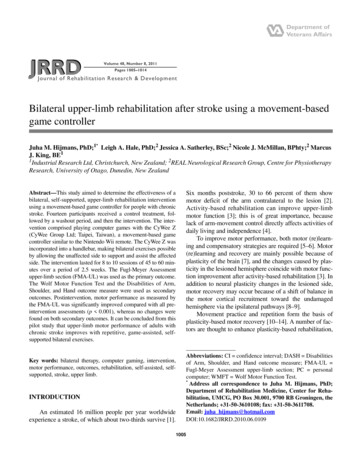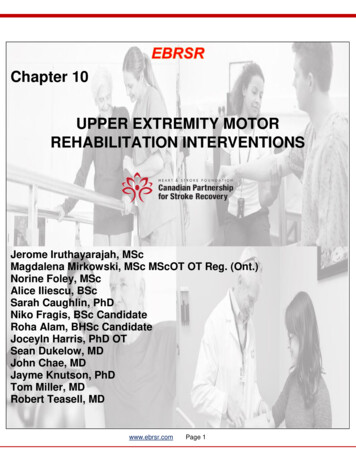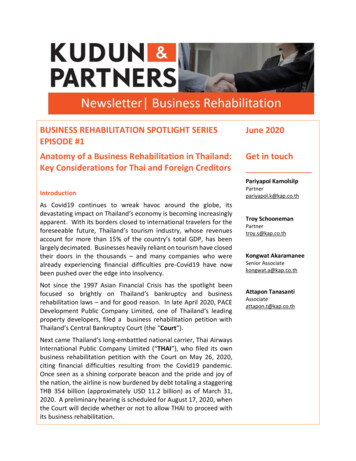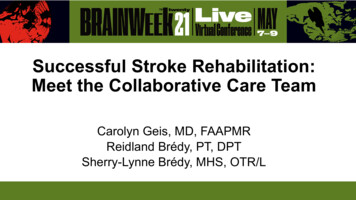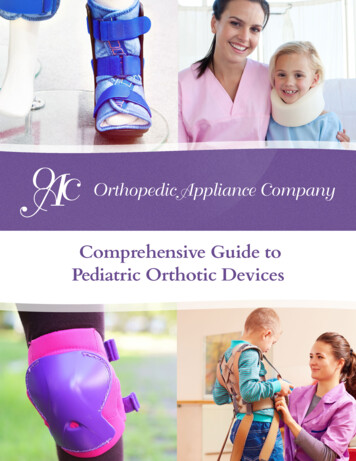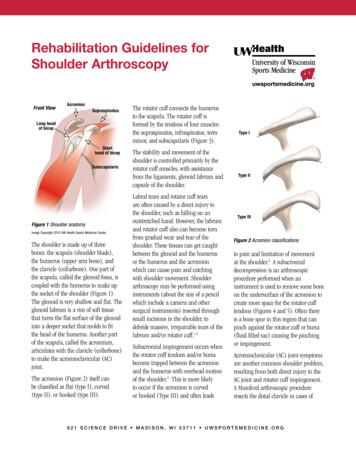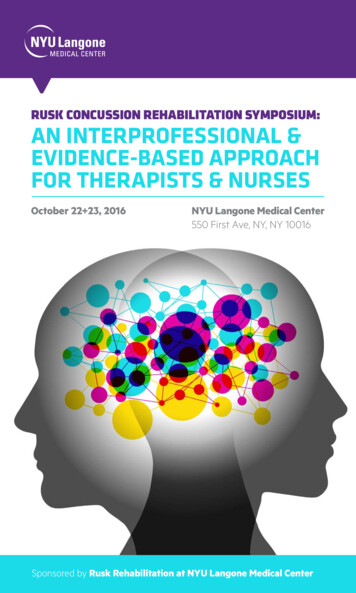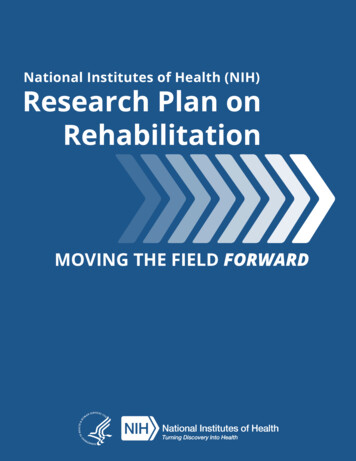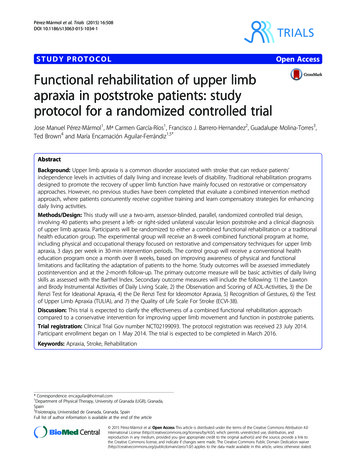
Transcription
Pérez-Mármol et al. Trials (2015) 16:508DOI 10.1186/s13063-015-1034-1STUDY PROTOCOLTRIALSOpen AccessFunctional rehabilitation of upper limbapraxia in poststroke patients: studyprotocol for a randomized controlled trialJose Manuel Pérez-Mármol1, Mª Carmen García-Ríos1, Francisco J. Barrero-Hernandez2, Guadalupe Molina-Torres3,Ted Brown4 and María Encarnación Aguilar-Ferrándiz1,5*AbstractBackground: Upper limb apraxia is a common disorder associated with stroke that can reduce patients’independence levels in activities of daily living and increase levels of disability. Traditional rehabilitation programsdesigned to promote the recovery of upper limb function have mainly focused on restorative or compensatoryapproaches. However, no previous studies have been completed that evaluate a combined intervention methodapproach, where patients concurrently receive cognitive training and learn compensatory strategies for enhancingdaily living activities.Methods/Design: This study will use a two-arm, assessor-blinded, parallel, randomized controlled trial design,involving 40 patients who present a left- or right-sided unilateral vascular lesion poststroke and a clinical diagnosisof upper limb apraxia. Participants will be randomized to either a combined functional rehabilitation or a traditionalhealth education group. The experimental group will receive an 8-week combined functional program at home,including physical and occupational therapy focused on restorative and compensatory techniques for upper limbapraxia, 3 days per week in 30-min intervention periods. The control group will receive a conventional healtheducation program once a month over 8 weeks, based on improving awareness of physical and functionallimitations and facilitating the adaptation of patients to the home. Study outcomes will be assessed immediatelypostintervention and at the 2-month follow-up. The primary outcome measure will be basic activities of daily livingskills as assessed with the Barthel Index. Secondary outcome measures will include the following: 1) the Lawtonand Brody Instrumental Activities of Daily Living Scale, 2) the Observation and Scoring of ADL-Activities, 3) the DeRenzi Test for Ideational Apraxia, 4) the De Renzi Test for Ideomotor Apraxia, 5) Recognition of Gestures, 6) the Testof Upper Limb Apraxia (TULIA), and 7) the Quality of Life Scale For Stroke (ECVI-38).Discussion: This trial is expected to clarify the effectiveness of a combined functional rehabilitation approachcompared to a conservative intervention for improving upper limb movement and function in poststroke patients.Trial registration: Clinical Trial Gov number NCT02199093. The protocol registration was received 23 July 2014.Participant enrollment began on 1 May 2014. The trial is expected to be completed in March 2016.Keywords: Apraxia, Stroke, Rehabilitation* Correspondence: encaguilar@hotmail.com1Department of Physical Therapy, University of Granada (UGR), Granada,Spain5Fisioterapia, Universidad de Granada, Granada, SpainFull list of author information is available at the end of the article 2015 Pérez-Mármol et al. Open Access This article is distributed under the terms of the Creative Commons Attribution 4.0International License (http://creativecommons.org/licenses/by/4.0/), which permits unrestricted use, distribution, andreproduction in any medium, provided you give appropriate credit to the original author(s) and the source, provide a link tothe Creative Commons license, and indicate if changes were made. The Creative Commons Public Domain Dedication o/1.0/) applies to the data made available in this article, unless otherwise stated.
Pérez-Mármol et al. Trials (2015) 16:508BackgroundApraxia is considered the inability to carry out learnedskilled motor acts despite the motor and sensory systemsbeing intact with respect to coordination, comprehension, and cooperation [1, 2]. Specifically, this disorder isviewed as any motor ability problem acquired in the absence of motor impairments, such as weakness, akinesia,loss of sensory input, abnormal tone or posture, ormovement disorder [3], which occurs as the result of aneurological dysfunction [4].Apraxic impairments are classified as higher motordeficits since they may manifest in the absence of primary sensory and motor deficits, disturbed communication or lack of motivation. As the disorder appears whenpatients are processing goal-directed actions [5, 6], it hasbeen characterized as a reduction in the patient’s abilityto voluntarily perform goal-directed movements [7].Limb apraxia (LA) is a subtype of apraxia covering awide spectrum of higher motor disorders caused by acquired brain disease or injury and affecting the performance of skilled learned movements carried out by theupper limbs [8]. It cannot be explained by intellectualdeterioration, poor comprehension, uncooperativenessor a deficit in the elemental motor or sensory system [9].Frequently observed clinical symptoms of LA are an inability to perform purposeful movements with one’sarms or hands, errors when asked to demonstrate howto use an object or how to carry out actions involving asingle or series of components of movements, and problems imitating abstract and symbolic gestures [5, 10].Thus, with LA, performance is characterized by a seriesof errors leading to an incomplete, inaccurate or incorrect gesture [5, 10].Limb apraxia subtypes are based on the classificationof Hugo Liepmann [11]. The subtypes of this syndromeare usually multimodal because they do not depend onthe modality of perceptual visual, verbal, or tactile stimuli that the person receives [12]. The two subtypes ofapraxia that have been described in the most detail inscientific literature are ideational apraxia (IA) and ideomotor apraxia (IMA). IA occurs when patients haveproblems performing a sequence of actions requiring theuse of various objects in the correct manner and ordernecessary to complete an intended goal. IMA is the inability to properly perform gesture pantomimes and imitations, whereas the use of real tools is less affected.Patients that present with IMA know cognitively what todo but do not know how to execute the movement. Theidea or plan for the action is not damaged, but implementation of the motor plan for turning gestures intoactions is impaired [12].The deficits linked to apraxia are typically associated with brain damage of vascular etiology, especiallyafter left hemispheric stroke [13–15]. Studies reportPage 2 of 10prevalence rates varying from 10 % to 50 % for thetraditional clinical classification of IA and IMA deficits after lesions in the left parietal and premotor cortical areas [6, 14, 15]. Patients with right-braindamage and IMA have also been reported, withprevalence rates from 20 % to 54 % [16, 17].Apraxia is therefore one of the common cognitive deficits that occur after a stroke. It can have negative impacts on a patient’s independence in activities of dailyliving (ADLs) [14] due to reduced levels of patient autonomy [18–20]. The disorder not only appears in clinical settings but also in many natural, day-to-dayenvironments [10] where patients commonly performADLs, that is, the daily activities required to live safelyand independently at home. The ecological relevance ofapraxia has been reported in the ability of patients toperform various ADLs, for example, feeding, bathing,toileting, and grooming, as well as dressing and brushingone’s teeth. Moreover, gesture deficits impact negativelyon patients’ nonverbal communication and the quality ofcommunicative gestures. For this reason, patients whohave apraxia rarely use spontaneous communicative gestures in daily living settings [5, 19–24].To promote the independence and safety of apraxiapatients’ daily functional performance, efficient costeffective and evidence-based intervention strategies forLA are needed. The most important interventions reported in the scientific literature that are currently usedfor upper limb apraxia can be divided into two approaches: restorative and compensatory. With the restorative method, damaged systems/processes aretreated directly, the objective being to bring the partiallyaffected abilities back to their functional level prior toillness. It focuses on the training of transitive and intransitive gestures, with the aim of restoring the patient’spre-morbid level of function. ADL training is most successful where patients have practiced the activitiesduring their daily routines in natural everyday environments. This gesture execution treatment regimen wasdeveloped by Smania and collaborators [6, 10, 25].Compensatory methods are based on providing strategies for patients to compensate for deficits associatedwith apraxia. By definition, a compensatory treatmentdoes not lead to the recovery of specific abilities but requires the damaged system to generate compensatorymechanisms. This approach was developed, with specifictraining strategies, by the Dutch group of Van Heugtenand collaborators [6, 12, 26, 27].Previous studies have reported that rehabilitative treatment of the cognitive functioning of patients with LAafter a stroke can bring about significant improvementsin the performance and recognition of both transitiveand intransitive gestures. Regaining praxis skills oftengeneralizes to improvements in ADL functioning as well.
Pérez-Mármol et al. Trials (2015) 16:508Furthermore, follow-up evaluations indicate that it couldhave long-term treatment benefits [10, 25].Evidence of the effectiveness of compensatory strategies through ADL training has also been found inthis client group. Results after an eight-week treatment period indicate that integrating specific strategytraining into the usual occupational therapy was moreeffective in improving ADL functioning than usual occupational therapy alone [14]. The results of a similarstrategy training approach demonstrated clinicallylarge and statistically significant impacts on all measures of ADL functioning, although small significantimprovements were found in tests on apraxia andmotor functioning. In the same study, 71 % of the patients had improved Barthel Index scores. These results suggest that the training appears to besuccessful in teaching patients compensatory strategies that enable them to function more independently, despite the residual impacts of apraxia [26].However, as this study did not include a controlgroup, these findings could have been affected byother factors. Although previous research has shownthat the effective management and treatment of LAhas the potential to have a marked impact on patientoutcomes, more rigorous empirical evidence is neededto demonstrate the effectiveness of rehabilitation approaches for upper limb apraxia [10]. Only a fewstudies have been published that have a suitably rigorous study design and a sufficiently large sample size.Also, the efficacy of different apraxia treatments hasonly been investigated in a few randomized controlledstudies [5].There is some debate as to whether teaching compensatory strategies reduces the likelihood that restorativeapproaches will be successful because, once learned,compensation is very difficult to modify; that is, it maybe difficult to unlearn compensated movement, and thismay frustrate any efforts to improve movement with restorative strategies [28, 29]. However, other authorsclaim that teaching compensatory and restorative frameworks should be combined to determine whether this isin fact true or whether, on the contrary, greater positiveeffects are achieved with a combined approach.To our knowledge, no studies have been completedusing a combined intervention approach, where patientsreceive cognitive training on apraxia in conjunction witha method that focuses on the strategies needed to promote ADL functional performance. Moreover, we arenot aware of any studies that incorporate an apraxiaintervention at home, in other words, in a natural dayto-day context. Hence, a more rigorously designed largescale randomized trial is needed to evaluate the effectiveness of a combined treatment approach to functionalrehabilitation at home that integrates both interventionPage 3 of 10approaches to LA function (restorative and compensatory) with autonomy in ADLs and quality of life (QoL)in poststroke patients.For these reasons, the overall objective of this randomized control trial is to evaluate the immediate andmedium-term effects of a combined functional rehabilitation intervention aimed at improving mild to moderateupper limb apraxia in poststroke patients, using a combination of restorative and compensatory approaches inthe patients’ home environments, in comparison with acontrol group who undergo a traditional health education protocol. The specific research aims are (a) to investigate the impact of a combined functional rehabilitationintervention approach on the independence of patientspresenting with an upper limb apraxia that affects theperformance of their basic/instrumental activities ofdaily living, (b) to compare the neuropsychological functional status of patients’ LA, and (c) to assess the impactof this combined intervention in upper limb apraxia onthe patient’s quality of life.Our study hypothesis is that changes induced by therestorative approach in combination with the compensatory approach could have positive effects on the performance of transitive/intransitive gestures, ADLs andQoL in patients with upper limb apraxia.Methods/DesignResearch designThis study will be conducted as a two-arm patient andtherapist-blinded, parallel, randomized controlled trialdesign, following the recommendations of the SPIRITguidelines (Additional file 1) [30]. The experimentalgroup will receive a combined functional rehabilitationprogram at home and will be compared to a controlgroup receiving a conventional health education program. The main outcome measures will be collected atthree time points over a 16-week period: (1) at baseline,(2) at posttreatment (that is, 8 weeks after baseline), and(3) at follow-up (16 weeks after baseline). The study assessment schedule is shown in Table 1. The study wasapproved on 26 May 2014 by the Investigation EthicsCommittee of Granada province-CEI (Andalusian HealthService, Granada, Spain, 180SP) and complies with the2013 modification of the Helsinki Declaration [31] andwith current Spanish legislation for clinical trials [32].ParticipantsForty patients with clinical evidence of left and rightsided unilateral vascular lesions poststroke and upperlimb apraxia will be recruited from the Neurology Unitof San Cecilio Hospital in Granada, Spain. Initial contactwith the patients will be made by telephone 2 monthsafter they sustained the stroke. Participants will be askedto talk face-to-face with the coordinators to discuss the
Pérez-Mármol et al. Trials (2015) 16:508Page 4 of 10Table 1 Schedule of enrollment, interventions, and assessments of the studyTime entTime 0Baseline8-weeks posttreatment2-month follow-upEnrollment:Eligibility screenXInformed consentXAllocationXInterventions:Combined functional rehabilitation of apraxia groupXXTraditional health educative protocol groupXXAssessments:Sociodemographic and clinical dataXBarthel indexXXXInstrumental Activities of Daily Living ScaleXXXObservation and scoring of ADL-ActivitiesXXXDe Renzi Test for ideational apraxiaXXXDe Renzi Test for ideomotor apraxiaXXXRecognition of gesturesXXXTest of upper limb apraxia (TULIA)XXXQuality of life scale for stroke (ECVI-38)XXXstudy and obtain information regarding the objectivesand characteristics of the research. Those who give theirvoluntary consent for participating in the study will beinterviewed and assessed by a neurologist to determinewhether they meet the study inclusion criteria. Writteninformed consent will then be obtained from all thosetaking part in the study. Figure 1 shows the flow diagram of the study participants.Eligibility criteriaThe criteria for inclusion in the study will be as follows:(a) age between 25 and 95 years; (b) presenting withmild to moderate effects of a stroke 2 months after acerebrovascular attack (this will be determined from aneurological examination and completion of the NIHstroke scale [33, 34]; (c) the presence of upper limbapraxia lasting at least 2 months; (d) voluntary participation; (e) intervention judged to be necessary by the neurologist, occupational therapist. and patient; and (f )patients presenting with apraxia, determined by a scoreof less than or equal to nine points on the validated toolfor apraxia screening (Apraxia screen TULIA) [35].The exclusion criteria have been established as follows:(a) a history of apraxia predating the current stroke; (b)having had a stroke less than 2 months or more than 24months previously; (c) cognitive impairment ( 23 pointsin the normal school population and 20 points with alow level of education or illiteracy, in accordance withthe Spanish version of the Mini-Mental State Examination) [36]; (d) severe aphasia (when the patients do notunderstand the commands or are unable to completethe screening tests); (e) a previous brain tumor; (f ) aprevious history of other neurological disorders; (g) having a mother tongue other than Spanish; (h) a history ofknown drug addiction; (i) a known intellectual or learning disorder; (j) brain damage from a traumatic or neurodegenerative process (k) a history of seriousimpairment of awareness; (l) the presence of orthopedicor other disabling conditions; and (m) the patient withholding consent to take part in the study.Randomization and blindingThe patients who volunteer to take part in the study willbe randomly allocated into two groups (the experimentaland control groups), using a computational randomnumber generator (EPIDAT 3.1, Xunta de Galicia) withrandomization codes created by MCGR. This will assignpatients to a combined functional apraxia rehabilitationgroup or a control group with an allocation ratio (1:1).During the randomization process, patients will beblinded to their treatment allocation. The neurologistwill examine the patients for eligibility criteria and collect all the baseline demographic variables but will notbe involved in the rest of the study or preparation of therandomization codes. Treatment allocation will be concealed and patients and study personnel will be blindedto the treatment assignments until after the database hasbeen locked. During the trial, all the outcome measureswill be collected by three therapists, who will be blindedto the group allocation. Treatment interventions will all
Pérez-Mármol et al. Trials (2015) 16:508Page 5 of 10Fig. 1 Flow diagram of study designbe carried out by an occupational therapist with wideclinical experience, who will be blinded to the outcome measures and baseline examination findings butnot to the patients’ treatment allocation, although thisallocation will not be revealed to the therapists whogather the outcome measure data. Criteria for receiving discontinued intervention will be as follows: 1)the participant requests voluntarily to miss any session, or 2) the interventions produce a significant improvement or worsening of apraxia disease. As part ofthe strategy to improve adherence to intervention, patients will be informed about the relevance of thetreatment in each session, and they will be telephonedweekly to remind the date of the sessions. The finalresult of the study will be reported to the patients inboth groups.Combined functional rehabilitation approach to apraxia(experimental group)The functional rehabilitation approach for upper limbapraxia consists of occupational therapy interventionbased on two complementary approaches. Informationabout these approaches has been published separately,and there is evidence that both approaches are effective[6, 10, 26]. The experimental group will receive an 8week combined functional rehabilitation program athome with an occupational therapist on 3 days per weekin 30-min intervention periods, focusing on restorativeand compensatory techniques for upper limb apraxia.Once the occupational therapist has identified the patient’s needs, the restorative program will be used in thefirst two of the weekly sessions, and the compensatorymethods in the last session of the week. Both methods
Pérez-Mármol et al. Trials (2015) 16:508will be used to improve the patients’ functional performance, allowing them to be more independent in differentdaily living contexts, especially in the home.In the restorative approach, developed by Smania et al.[6, 10], treatment is designed in three sections, directedtowards transitive, intransitive-symbolic and intransitivenonsymbolic gestures, respectively. Transitive gesturetraining is subdivided into three phases: A, B, and C. Inphase A, the patient is required to demonstrate the useof common tools. In phase B, the patient is shown a picture illustrating a transitive gesture and is then requiredto mime or imitate that gesture. In phase C, the patientis presented with a picture showing a common tool andis then asked to demonstrate how it is used by pantomiming. Each phase contains 20 items. When the patient is able to correctly perform at least 17 of the 20items, that phase is concluded and the following phase isinitiated [6, 10].Intransitive-symbolic gesture training is also subdivided into phases A, B, and C, depending on the numberof contextual cues used under the different conditions.In intransitive-nonsymbolic gesture training, the patientis asked to imitate meaningless intransitive gestures previously shown by the examiner. Twelve gestures, involving six proximal and six distal joints, are delivered. Halfof the gestures are static, and the rest are dynamic. Patients who are unable to perform the gesture properlyare assisted by the examiner with verbal or other appropriate facilitation [6, 10].The compensatory approach is based on the work ofVan Heugten et al. [6, 26]. The treatment consists oftherapy sessions that focus on teaching patients strategies to compensate for deficits linked to apraxia.Greater improvement in ADL functioning is typically expected from implementation of the compensatory approach, rather than the recovery of motor impairments.Patients become more independent in performing everyday activities when they are taught internal and externalstrategies, such as the use of oral and written instructions, or picture sequences that can compensate for anyfunctional deficits caused by apraxia during the execution of their everyday activities. Compensation can beprovided in two ways: externally (by the therapist), usingmaterials that help the patient to perform an action (forexample, photographs depicting the correct sequence ofan action), and internally (generated by the patientsthemselves) by relying on intact cognitive functions (forexample, verbalizing the sequence of distinct actions thepatient is supposed to complete) [6, 26].The decision about which activity to work on will bemade collaboratively with the patient and the occupational therapist. The therapist will take into account thedecision tree and principles used by Van Heugten et al.to guide the selection of a specific activity and apply aPage 6 of 10checklist of activities. The checklist will consist of an assessment of the activities the patient performed prior tothe stroke and those activities that are relevant to thepatient for future performance. The interventions implemented during the compensatory sessions are based onspecific difficulties noted during standardized ADL observations [6, 26].ADL activities are conceived as three successivephases, conforming to the information processing framework: initiation, execution, and control. For example, apatient with apraxia who cannot use objects appropriately may have a deficit at any one of the stages of theactivity being performed. By evaluating the differentcomponents of the activity, the structure of the deficitcan be recognized, and the design of the treatment canbe formulated accordingly [6, 26].Traditional health education protocol (control group)The control group patients will receive a health education program only. They and their caregivers will attenda series of education workshops where they will be giveninformation about what having a stroke involves, themeaning of upper limb apraxia, the implications ofupper limb apraxia on daily living at home, and thecommon types of challenges arising from apraxia withrespect to the daily use of a person’s upper limb. Theworkshops will take place at the patient’s home once amonth over a 2-month period. After completion of thestudy, this group will be offered the opportunity to participate in the combined approach intervention, although the data from this will not be used in thestatistical analysis.AssessmentPrimary outcome measureBarthel Index The Barthel Index (BI) for ADLs is awidely used standardized scale for assessing functionaldisability in basic ADLs. It scores ten basic activities:bowel control, bladder control, grooming, toilet use,feeding, transfer, mobility, dressing, using the stairs andbathing. The score generated varies from zero (totallydependent) to a maximum score of 20 (totally independent). It has good interobserver reliability, with a Kappastatistic between 0.47 and 1.00, and good intra-observerreliability, with a Kappa statistic between 0.84 and 0.97[37]. In a study involving a poststroke participant group,the internal consistency of the BI was a Cronbach’s alphaof 0.92 [38].Secondary outcome measuresGeneral functionality and autonomyThe Lawton and Brody Instrumental Activities of DailyLiving Scale is a questionnaire used to assess the ability
Pérez-Mármol et al. Trials (2015) 16:508to develop the instrumental activities necessary for livingindependently in the community. It is a selfadministered scale validated for the Spanish population[39]. The maximum score of 8 points indicates completeindependence, a score of 6 to 7 mild dependence, 4 to 5moderate dependence, 2 to 3 severe dependence, and 0to 1 total dependence. It has high inter- and intraobserver coefficients of reliability (0.94) and high testretest reliability (0.95) [39, 40].The Observation and Scoring of ADL Activities is atest that consists of observing the performance of activities of daily living with a system of standardized observations specially developed for assessing disabilitycaused by apraxia. The overall score varies from totallydependent (0) to fully independent (3). The Kappa statistic shows values higher than 0.70, indicating considerable agreement [38]. The inter-observer reliability ofeach assessed activity varies with the intraclass correlation coefficients from 0.62 to 0.98 [41].Neuropsychological testsThe De Renzi Test for Ideational Apraxia assesses ideational apraxia in the upper limbs and requires the use ofreal objects. Patients are asked with words and gesturesto take an object in their hands and demonstrate howthey would use it. Two points are assigned for an immediate correct response, and one point is assigned if a correct performance is preceded by hesitation or aprotracted latency period during which wrong or unsuccessful movements are presented or if the performanceis conceptually correct but the actual movements aresomewhat inaccurate or awkward. For any other type oferror, no points are given. The score varies from zero to14 points [16].The De Renzi Test for Ideomotor Apraxia requires patients to reproduce a wide variety of intransitive gestures, that is, gestures that do not require the use ofobjects. The gestures may be symbolic (for example, theOK sign) or nonsymbolic (hand under the chin). Patientsare assigned a maximum of three points if they performthe gestures correctly after the first demonstration, andtwo or one points, depending on whether they need asecond or third demonstration. If all the demonstrationsare unsatisfactory, no points are given. The test consistsof 24 items and the total test score varies from zero to72 points [42].Recognition of Gestures tests both transitive andintransitive-symbolic gestures, following the recommendations of Smania et al. [10]. For transitive gestures, thepatient is given three pictures showing an action performed a) with an object, b) with a semantically relatedbut inappropriate object, or c) with a semantically unrelated inappropriate object. Patients are required to indicate the picture in which the correct transitive gesture isPage 7 of 10reproduced. As for intransitive symbolic gestures, thepatient is given three pictures showing different symbolic gestures, one of which is related to a context represented in another picture. The remaining two picturesshow gestures with or without postural affinities withthe correct gesture. The patient is requested to indicatethe picture showing the gesture related to the context.The test includes five transitive and five intransitive gesture recognition trials. One point is given for each correct response, with the resultant scores varying fromzero to ten points [10].The Test of Upper Limb Apraxia (TULIA) for Comprehensive Assessment of Gesture Production has a totalof 48 items, grouped into six subtests, for imitating gestures and simulating gestures that are nonsymbolic(meaningless), intransitive (communicative), and transitive (related-objects). It has a Likert scale from zero tofive points per item, with a total score varying from zeroto 240 points [43]. Evidence shows that this test is a reliable and valid assessment of gesture production. It cantherefore be easily applied for the purposes of researchand clinical practice. It has a good to excellent internalconsistency and test-retest reliability at both the level ofthe six subtests and the individual level of the items. Fortest-retest reliability at item level in patients examinedthree times within 24 hours, it has been shown thatmost items (n 39) had a go
of Upper Limb Apraxia (TULIA), and 7) the Quality of Life Scale For Stroke (ECVI-38). Discussion: This trial is expected to clarify the effectiveness of a combined functional rehabilitation approach compared to a conservative intervention for improving upper limb movem
